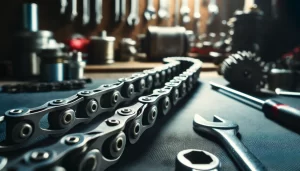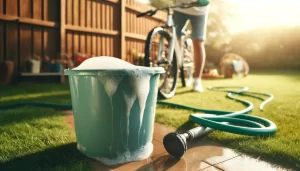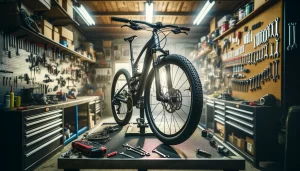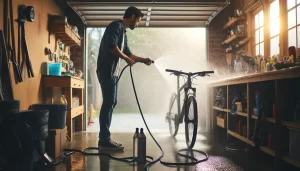Maintenance bike practices are not just routine chores; they are essential rituals that every cyclist should embrace to ensure their bike performs at its best. By dedicating a little time and effort to regular maintenance, you can dramatically enhance your bike’s longevity and reliability.
Whether you’re a daily commuter or a weekend warrior, understanding the basics of bike upkeep can prevent common mechanical failures and ensure a smoother ride. This comprehensive guide to preventive bike maintenance is designed to help you easily navigate the sometimes complex world of bike mechanics.
From simple cleaning techniques to more detailed adjustments, we’ll equip you with the knowledge and skills needed to maintain your bike in top condition. Keep reading to discover how you can transform your maintenance routine into an enjoyable part of your cycling experience, saving you time and money in the long run.
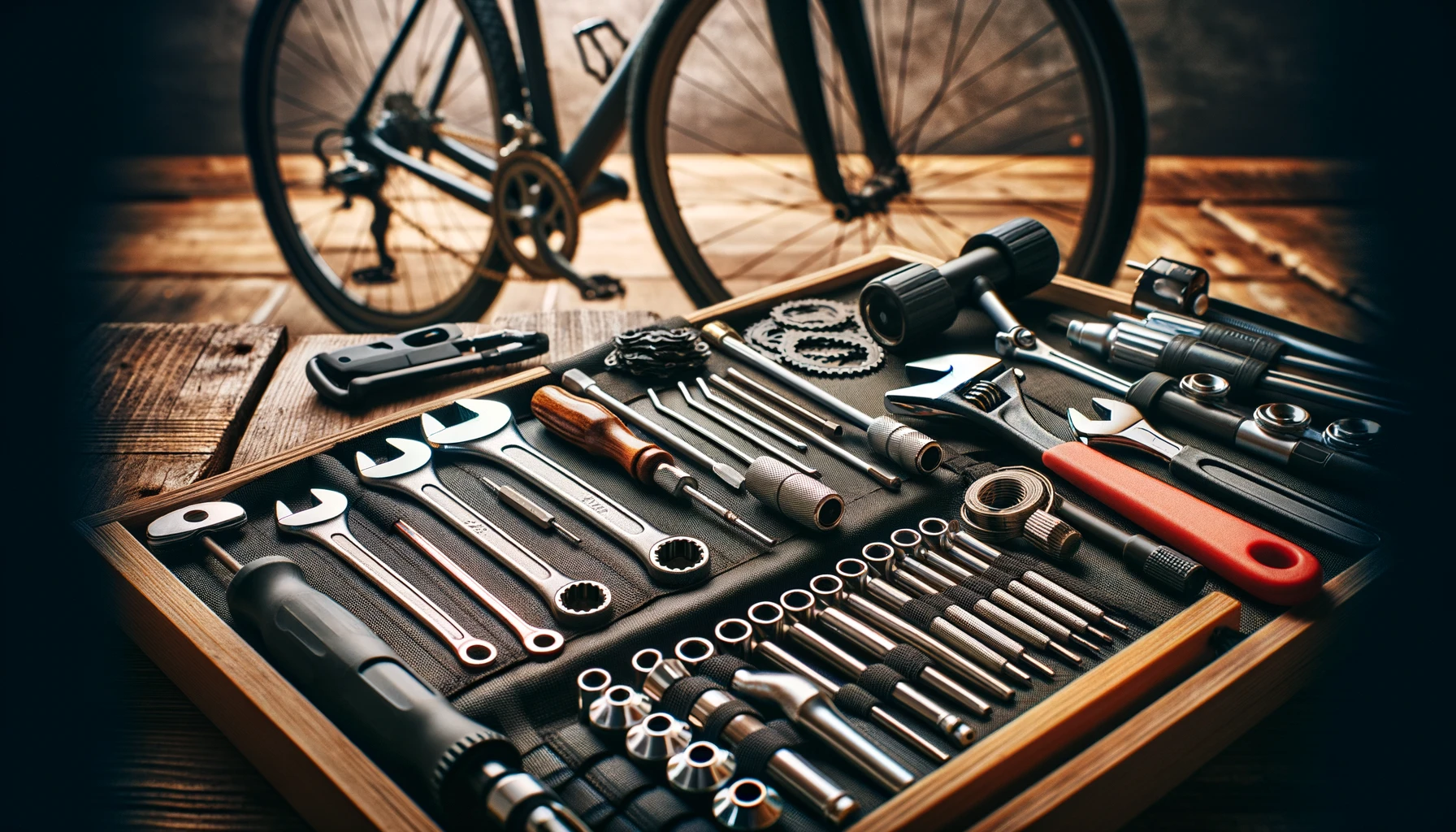
Image Source: Image Generated With DALL-E on ChatGPT
Importance of Preventive Maintenance for the Longevity of Your Bike
Preventive maintenance is crucial in extending the lifespan of your bicycle and ensuring its performance remains optimal. Regular maintenance prevents minor issues from developing into major problems, potentially saving you from expensive repairs or replacements.
It involves inspecting, cleaning, and adjusting all major components such as brakes, gears, and tires. This proactive approach not only improves safety by ensuring your bike is always in good condition but also enhances your riding experience by keeping the bike smooth and responsive.
Steps for Effective Preventive Maintenance:
- Regular Inspection: Check your bike every month for any signs of wear or damage.
- Cleaning: Clean your bike after every ride to remove dirt and grime, which can wear out components.
- Lubrication: Regularly lubricate the chain, gears, and cables to ensure smooth operation.
- Tire Pressure: Always maintain the recommended tire pressure to avoid flats and uneven wear.
- Professional Servicing: Have your bike professionally serviced at least once a year for a thorough checkup.
Tips for Maintaining Your Bike’s Suspension
Maintaining your bike’s suspension is key to ensuring a comfortable and controlled ride, especially on uneven terrains. Suspension systems absorb shocks and maintain contact between the tires and the ground, providing stability and comfort. Neglecting this component can lead to poor handling and increased wear on other parts of your bike.
Tips for Keeping Your Suspension in Top Shape:
- Regular Cleaning: Clean the suspension components to remove dirt and debris that can cause wear.
- Check for Leaks: Regularly check for oil or air leaks in suspension seals.
- Lubrication: Apply appropriate lubricants to the suspension pivots and seals to prevent friction and wear.
- Adjustment: Adjust the suspension settings according to your weight and riding style for optimal performance.
- Professional Checks: Have a professional check your suspension system annually to ensure it is functioning correctly.
Prevention of Rust and Corrosion on Bike Parts
Rust and corrosion can significantly shorten the life of your bicycle’s components. These issues are typically caused by exposure to moisture, dirt, and salt, which can attack metal parts. Preventing rust not only extends the durability of your bike but also maintains its aesthetic appeal.
Key preventative measures include proper cleaning, storage, and regular maintenance. By keeping your bike dry and clean, and using corrosion-resistant products, you can significantly reduce the risk of rust and maintain the functionality and look of your bike.
Steps to Prevent Rust and Corrosion:
- Regular Cleaning: Wash your bike regularly to remove dirt, salts, and chemicals.
- Dry Thoroughly: After cleaning, dry your bike completely to prevent moisture from settling.
- Use Protection: Apply anti-rust sprays or coatings to metal parts, especially if you live in a humid or coastal area.
- Proper Storage: Store your bike in a dry, covered area away from direct exposure to harsh weather.
- Inspect Regularly: Check for early signs of rust or corrosion and address them immediately.
How to Lubricate Your Bike Chain
Lubricating your bike chain is essential for smooth cycling and prolonging the life of your drivetrain. A well-lubricated chain reduces friction, prevents wear, and keeps your ride quiet and efficient. The type of lubricant and the frequency of application depend on your riding conditions. Regular lubrication is especially important if you frequently cycle in wet or muddy conditions.
Steps for Lubricating Your Bike Chain:
- Clean the Chain: Before lubricating, thoroughly clean the chain with a degreaser to remove old lubricant and debris.
- Apply Lubricant: Apply a suitable lubricant evenly along the length of the chain while turning the pedals to ensure it spreads.
- Wipe Excess: After applying, gently wipe off any excess lubricant with a clean rag to prevent attracting dirt.
- Regular Maintenance: Lubricate your chain regularly, especially after riding in wet conditions or after cleaning your bike.
- Choose the Right Lubricant: Use a lubricant appropriate for your typical riding conditions—wet or dry formula depending on the environment.

Image Source: Image Generated With DALL-E on ChatGPT
How to Change and Care for Your Bike Tires
Changing and maintaining your bike tires is an essential skill for any cyclist, crucial for ensuring safety, performance, and comfort on rides. Regular tire maintenance can prevent flats and ensure optimal traction and handling.
To change a tire, you first need to remove the wheel, then the old tire and tube, checking for any debris or sharp objects in the rim that might puncture the new tube. When installing the new tube and tire, be careful to fit it evenly and inflate it to the pressure specified on the tire’s sidewall. This avoids uneven wear and punctures.
Caring for your bike tires extends beyond just changing them. Regular inspections for wear and tear, cuts, or embedded objects help prevent sudden failures. Tires should be kept at the correct pressure, as underinflated tires can lead to pinch flats and overinflated ones can make for a harsh ride.
Additionally, rotating your tires from front to rear halfway through their life span can promote even wear and extend their usability. Using tire liners or sealants can also provide an extra layer of protection against punctures, especially beneficial for riders frequently encountering rough terrain.
How to Perform Basic Adjustments on Your Bike’s Derailleur
Adjusting a bike’s derailleur is vital for smooth and efficient gear shifting, which enhances the overall cycling experience. The derailleur controls the movement of the chain between different gears. If the bike is not shifting cleanly or the chain is dropping, it might be time to adjust the derailleur.
This process typically starts with setting the limit screws, which control how far the derailleur can move towards or away from the bike, preventing the chain from falling off the gear range. Additionally, the cable tension needs to be adjusted to ensure responsive shifting.
When performing these adjustments, it’s important to shift through all gears to check for smoothness and to make fine adjustments as needed. If the chain skips or hesitates during shifting, further tweaking of the cable tension might be necessary.
Regular maintenance checks should include a look at the derailleur’s alignment and cleanliness, as dirt and grime can significantly affect its performance. Keeping the derailleur well-lubricated and free of debris not only ensures optimal functionality but also extends its lifespan. Proper adjustments require patience and attention to detail but mastering this skill can significantly enhance your bike’s performance and your riding pleasure.
Checking and Maintaining Bike Pedals
Bike pedals are crucial for a smooth and efficient riding experience, and maintaining them properly is essential. Pedals bear a significant amount of stress and wear due to constant use and direct contact with the rider’s feet.
Regular checks should focus on ensuring that the pedals are securely attached to the crank arms and that there is no excessive play or wobbling. It’s also important to check for any signs of wear or damage to the pedal body and the threads. For maintenance, cleaning the pedals and applying a lubricant to the bearings and threads can prevent squeaking and stiffness, ensuring a smooth rotation.
Beyond basic checking and lubrication, maintaining your bike’s pedals might involve servicing the bearings or replacing worn-out pedals. For pedals with sealed bearings, servicing is typically less frequent but may require specific tools and skills to replace the bearings when they wear out.
Clipless pedal systems, which secure the cycling shoe to the pedal, require additional attention to ensure that the cleat mechanism works properly and safely. Regularly clearing mud and debris from the cleat mechanism and checking the cleats on cycling shoes for wear are also vital steps in pedal maintenance that enhance performance and safety.
Safety Checks Before Cycling
Performing a thorough safety check before heading out on a bike ride can prevent accidents and ensure a safe and enjoyable experience. This pre-ride inspection should start with the ABCs: Air, Brakes, and Chain. Ensure your tires are inflated to the proper pressure to avoid flats and ensure efficient riding.
Check the brakes for proper function; the brake levers should not touch the handlebar when pressed, and the brake pads should make even contact with the rims without touching the tires. Lastly, inspect the chain for proper tension and lubrication, and ensure it shifts smoothly across the bike gears.
Further safety checks include ensuring all bolts and fasteners are tight to prevent parts from loosening during the ride. This includes checking the seat, handlebars, and wheels. It’s also important to ensure the handlebars and stem are aligned.
Finally, check the lighting and reflective elements if you plan to ride in low-light conditions. These safety checks not only contribute to a safer ride but also enhance the overall performance of your bike, helping to avoid mid-ride mechanical failures that could lead to accidents.

Image Source: Image Generated With DALL-E on ChatGPT
Frequently Asked Questions About Bike Maintenance
1. How often should I perform maintenance on my bike?
Regular maintenance schedules can vary based on how frequently the bike is used and in what conditions. Generally, a monthly check-up is recommended for casual riders, while more frequent checks are necessary for daily commuters or competitive cyclists.
2. What are the essential tools I need for basic bike maintenance?
A basic toolkit for bike maintenance should include a set of hex wrenches, a tire pump, tire levers, a patch kit, a chain tool, and a screwdriver. Investing in a bike stand can also make maintenance tasks easier and more efficient.
3. How do I know when to replace my bike chain?
A bike chain typically needs replacement after 2,000 to 3,000 miles of use, but this can vary based on riding conditions. A chain wear indicator tool can help you determine if your chain is due for replacement.
4. Can I perform maintenance tasks myself or should I go to a professional?
Many maintenance tasks, such as cleaning and lubricating the chain, adjusting the brakes, and changing tires, can be done at home with some basic knowledge and tools. However, more complex tasks, such as adjusting the derailleur or overhauling bearings, might require professional service, especially if you’re not comfortable doing them yourself.
5. What is the best way to clean my bike?
Your bike can be effectively cleaned with soap and water. Use a soft brush to clean the frame and components, and a degreaser for the drivetrain. Rinse with low-pressure water and dry thoroughly to prevent rust.
Maintaining your bicycle is not just about keeping it functional; it’s also about ensuring safety and prolonging the life of its components. Regular maintenance checks can save you from costly repairs in the future and provide a more enjoyable riding experience.
By understanding and performing routine maintenance, cyclists can not only keep their bikes in top condition but also gain a deeper appreciation for the mechanics of their rides.
For those new to cycling or bike maintenance, starting with simple tasks and gradually learning more complex maintenance can enhance your cycling experience and equip you with valuable skills. Whether you choose to do it yourself or seek professional help, maintaining your bike is an essential part of cycling that should not be overlooked.
Did you like the article? Be sure to check out more content like this in the Maintenance Guide category or see more related content below.


